Urban planners were idealizing smart cities as far back as Greek antiquity. Today, the desire to optimize the world’s cities calls for enhanced technological access and easy use of city facilities. The moniker of “smart city” speaks to a future with problem-solving at the forefront.
What do Smart Cities Involve?
Unfortunately, “there is no absolute definition of a smart city…but rather a process, or series of steps, by which cities become more liveable and resilient.” The urban planners of the 20th century were ill-prepared for the unprecedented industrialization of the American city and the various flights of the suburbans. Smart city planners take on many tasks to improve upon the way a community traditionally responds to these types of novel challenges, including:
- collecting necessary data from the present municipality, if available
- establishing optimized public utilities to increase the quality of life
- identifying new ideas for sustainable systems
- recognizing vendors, partners, and other investors to see the project through
- collaborating with stakeholders and end-users to test, measure, and execute initiatives
How do Smart Cities Establish Optimized Public Utilities?
Smart Grids
A key component of the sprawling city is the electrical grid. With an increasing population, there will be more of a burden on stored energy, radio frequencies, and microwaves to connect the much-needed broadband cables and antennae network that brings us the Internet of things. Urban planners work with radio technicians and designers to coordinate for improved fail safes. These professionals may consider researching product frameworks with rf power dividers to avoid broadband outages, even in the event of transmitter failure.
Smart Waste
Urban planners do well to adopt household permaculture changes. Appliances like home composters help the city to reduce landfill waste and have the added benefit of providing free soil to each home for cultivating one’s food. In addition, the city must impact the disposal aspect of dumping to consider themselves economical. Fill level sensors, for instance, remotely monitor the levels of garbage from each residence, replacing the weekly and often inefficient routine pickups. Then, when areas where large amounts of waste gathered seemingly overnight, the removal trucks will take away the food scraps and excess containers, bypassing the areas where trash sites are yet manageable, thus streamlining the smart trash management process.
Smart city planning is adopting continuous living systems and practices to better the lives of citizens. The benefit comes when the individual, connected to the goals of the community, is able to contribute to the elevation of their home space.







